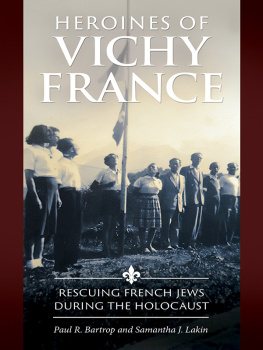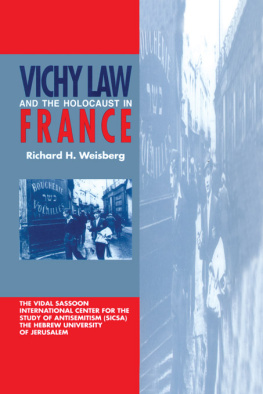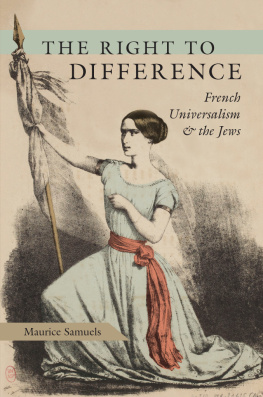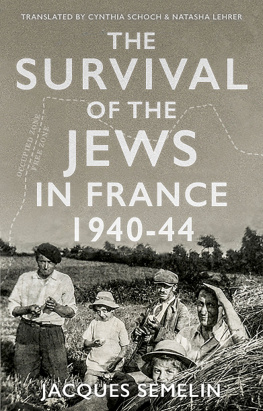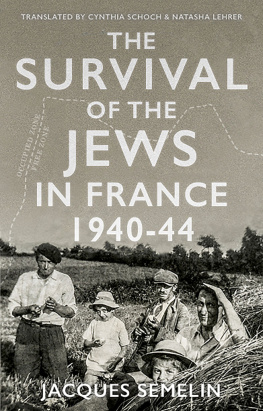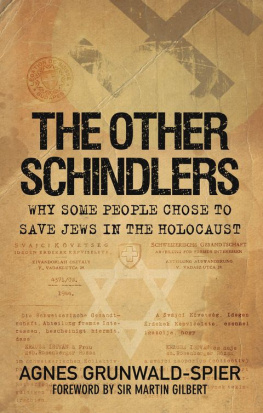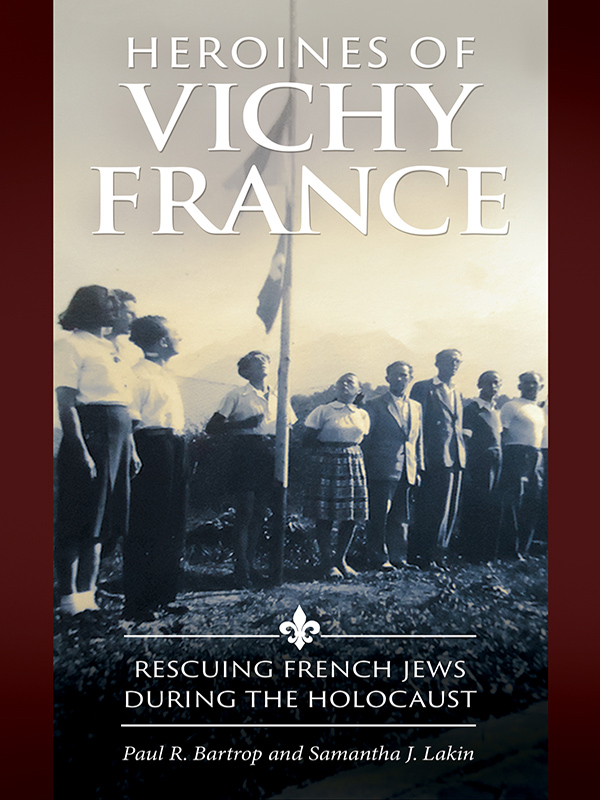Heroines of Vichy France
Heroines of Vichy France
Rescuing French Jews during the Holocaust
Paul R. Bartrop and Samantha J. Lakin

Copyright 2019 by Paul R. Bartrop and Samantha J. Lakin
All rights reserved. No part of this publication may be reproduced, stored in a retrieval system, or transmitted, in any form or by any means, electronic, mechanical, photocopying, recording, or otherwise, except for the inclusion of brief quotations in a review, without prior permission in writing from the publisher.
Library of Congress Cataloging-in-Publication Data
Names: Bartrop, Paul R. (Paul Robert), 1955 author. | Lakin, Samantha J., author.
Title: Heroines of Vichy France : rescuing French Jews during the Holocaust / Paul R. Bartrop and Samantha J. Lakin.
Description: Santa Barbara, California : Praeger, an Imprint of ABC-CLIO, LLC, [2019] | Includes bibliographical references and index.
Identifiers: LCCN 2019001009 (print) | LCCN 2019001157 (ebook) | ISBN 9781440852336 (ebook) | ISBN 9781440852329 (alk. paper)
Subjects: LCSH: JewsFranceHistory20th century. | Jewish women in the HolocaustFranceBiography. | Holocaust, Jewish (19391945)France. | World War, 19391945JewsRescueFrance. | World War, 19391945Underground movementsFrance. | FranceEthnic relations.
Classification: LCC DS135.F89 (ebook) | LCC DS135.F89 B36 2019 (print) | DDC 940.53/18350944dc23
LC record available at https://lccn.loc.gov/2019001009
ISBN: 978-1-4408-5232-9 (print)
978-1-4408-5233-6 (ebook)
23 22 21 20 19 1 2 3 4 5
This book is also available as an eBook.
Praeger
An Imprint of ABC-CLIO, LLC
ABC-CLIO, LLC
147 Castilian Drive
Santa Barbara, California 93117
www.abc-clio.com
This book is printed on acid-free paper 
Manufactured in the United States of America
Paul R. Bartrop dedicates this book to the memory of Ray Duplain (19392013): mentor, colleague, and very dear friend.
Samantha J. Lakin dedicates this book to the memory of Marian Diamond (19302006): matriarch of education, loving grandmother, and personal inspiration.
It is intolerable that war should involve the very youngnot only because in them the hope of the future lies, but because in their weakness and their irresponsibility they make so confident an appeal to our protection.
Marc Bloch, Ltrange Dfaite
Contents
The genesis of this book lay in an earlier study undertaken by Paul Bartrop that appeared in 2016. Even while Resisting the Holocaust: Upstanders, Partisans, and Survivors was in production, Steve Catalano of Praeger and Padraic (Pat) Carlin of ABC-CLIO contacted him to ask whether he thought any of those he was then profiling could be the subject of a broader, more individualized treatment. After a quick review of the many possibilities presenting themselves, the idea of combining three of the resister/rescuersMila Racine, Marianne Cohn, and Charlotte Sorkineinto a single work began to take shape. From there, and after much reflection, it became clear that a composite work examining all three could not be composed in isolation from the many others, women and men, with whom they and their organizations interacted. The result is the book you hold in your hand.
There was, however, still more to it than that. While it was necessary to learn the intricacies of the environment in which Jewish rescuers of Jews were forced to live during World War IIthe murderous dark that was the Holocaustit was also vitally important to realize that generalizing the experience was an impossibility due to the individuality of each persons situation. Samantha Lakins research was a clear addition to pursuing this task. As she interviewed 61 Jewish children and rescuers who survived the Holocaust by being smuggled through Jewish rescue networks to safety in Switzerland, stories emerged about the individuality of each persons situation, significant yet among the themes of rescue in the face of the gravest atrocity and genocidespecifically, the Holocaust.
Focusing on just a few young women, therefore, provided the authors with the opportunity to show how the Holocausts impact could be mitigated through smuggling Jewish children across the border between France and Switzerland. As we show, rescue served as a form of resistance, in which the saving of lives was as much a priority for some people as the defeat of the Nazis and their collaborators.
This book looks closely at the region of France known as the Haute-Savoie, close to the border with Switzerland near Geneva. Not only does it examine the complicated situation in that regionwhere rescuers had to deal with German Nazis, Italian Fascists, and Vichy policebut it also gives those who were rescued a voice, providing readers with insight into how they have recalled the intense (and often traumatic) period of their rescue. We also show the heroic (and sometimes tragic) fate of the rescuers, who were heroines not only of the French resistance but also of humanity.
Although other studies of Vichy (France), the Holocaust, and/or resistance look at a range of responsespolitical, ideological, literary, militaryfew have looked at the rescue of Jews by those prepared to risk everything through escorting them to safety in the border regions. Even fewer have considered Jewish rescue of Jews (or of Jewish children, specifically) or of such rescues being carried out by women. At best, this might have been dealt with in passing, in general studies. This book, therefore, is arguably the first in which the experiences and efforts of a number of rescuersall of whom knew or knew of each otherhave been brought together in a single volume with the object of honoring their memory and showing how the value of human life could be upheld during the Holocaust.
Within this context, the narrative is driven by courage and sacrifice of the rescuers efforts in trying to save Jews (principally, Jewish children) by spiriting them out of France during the second half of the war years. To do so, it has been deemed necessary to contextualize the story by looking at the position of Jews in France in the lead-up to and outbreak of the war itself, during which the ideals of republican democracy were constantly being challenged, and a constant battle for Frances future was being fought in a society deeply divided between those on the left and the right of politics.
Given this background, we also examine the course of antisemitism in France before the war, as this provided fertile ground for the policies adopted by the collaborationist government of Marshal Philippe Ptain, located at Vichy after the fall of France in the summer of 1940. As a result, to further contextualize the milieu in which the rescues took place, we show the experience of Jews in France during the war.
In addition, it was essential that we explore the complexity of the resistance and rescue networks and those involved. Some were Jewish; indeed, Jews were among the first and most active resisters in France during the period of the Nazi occupation and division of the country in German and Vichy zones. Yet there were also anti-Nazi resistance networks that were not Jewish, yet they dedicated themselves to the protection of Jews and engaged in smuggling activities in order to save Jewish lives. Clearly, these had to be considered here, particularly as there were linkages between groups that saw themselves all working toward the same goal.

